Intrarift fault interactions: Insights from coseismic stress redistribution from large seismogenic segment ruptures, Northern Malawi Rift
IF 2.6
2区 地球科学
Q2 GEOSCIENCES, MULTIDISCIPLINARY
引用次数: 0
Abstract
The understanding of the factors influencing the active interaction and coalescence of intrarift fault segments in extending continental regions is limited. The 2009 Mw6.0 Karonga earthquake occurred in the westernmost portion of the Northern Malawi Rift, which hosts clustered intrarift faulting. The event ruptured the strongly coalesced southern segment of the St. Mary Fault (sSMF), and subsequently, moderate-magnitude events localized on poorly -coalesced segments that define the northern continuation of the fault. To investigate the role of coseismic stress redistribution on interacting faults, we explore the slip distribution of the 2009 event with realistic 3D strike-variable fault geometries, and compute coseismic Coulomb stress changes around the sSMF and neighboring faults. The results suggest that the down-dip intersections of the sSMF with the neighboring faults partition strain in a way that directs most of the deformation to >5 km depths. Additionally, the coseismic stress changes from the 2009 earthquake promoted interactions between the sSMF and adjoining northern segments of the fault at shallow (<5 km) depths, indicating that upper-crustal hard-linkage is underway in the poorly coalesced en-echelon sections of the northern segment. These results demonstrate how coseismic static stress transfer between evolving intrarift fault systems drive fault linkage over a single seismic cycle. Over successive slip events, such stress transfer processes may accelerate the linkage and coalescence of contiguous intrarift fault segments, amalgamate and deepen sub-basins along-strike, and promote across-rift basin compartmentalization. This process is relevant for fault coalescence over multi-seismic cycles, progressive maturation of rift basins, and transitions from juvenile continental rifting to the development of margins where break-up can initialize.
岩内断层相互作用:来自马拉维裂谷北部大发震段破裂同震应力重分布的见解
对扩展大陆区域内断层段活跃相互作用和合并的影响因素的认识有限。2009年的Mw6.0卡隆加地震发生在马拉维北部裂谷的最西端,那里有聚集的内部断层。该事件破坏了圣玛丽断层(sSMF)强烈合并的南段,随后,中等规模的事件定位于确定断层北部延伸的弱合并段。为了研究同震应力重分布对相互作用断层的影响,我们利用真实的三维走向-可变断层几何形状,探索了2009年地震的滑动分布,并计算了sSMF及其邻近断层周围的同震库仑应力变化。结果表明,sSMF与邻近断层的下倾交点以一种将大部分变形引导至5 km深度的方式分配应变。此外,2009年地震的同震应力变化促进了sSMF与相邻断层北段在浅层(< 5km)深度的相互作用,表明在北段合并程度较差的阶梯式剖面上正在进行上地壳硬联结。这些结果表明,在单个地震旋回中,演化中的内断层系统之间的同震静态应力传递如何驱动断层联系。在连续的滑动事件中,这种应力传递过程可能会加速连续的断层内断裂段的联系和合并,沿走向合并和加深子盆地,并促进跨裂谷盆地的分区化。这一过程与多次地震旋回的断层合并、裂谷盆地的逐渐成熟以及幼年大陆裂谷向可以初始破碎的边缘发育过渡有关。
本文章由计算机程序翻译,如有差异,请以英文原文为准。
求助全文
约1分钟内获得全文
求助全文
来源期刊

Journal of Structural Geology
地学-地球科学综合
CiteScore
6.00
自引率
19.40%
发文量
192
审稿时长
15.7 weeks
期刊介绍:
The Journal of Structural Geology publishes process-oriented investigations about structural geology using appropriate combinations of analog and digital field data, seismic reflection data, satellite-derived data, geometric analysis, kinematic analysis, laboratory experiments, computer visualizations, and analogue or numerical modelling on all scales. Contributions are encouraged to draw perspectives from rheology, rock mechanics, geophysics,metamorphism, sedimentology, petroleum geology, economic geology, geodynamics, planetary geology, tectonics and neotectonics to provide a more powerful understanding of deformation processes and systems. Given the visual nature of the discipline, supplementary materials that portray the data and analysis in 3-D or quasi 3-D manners, including the use of videos, and/or graphical abstracts can significantly strengthen the impact of contributions.
 求助内容:
求助内容: 应助结果提醒方式:
应助结果提醒方式:


